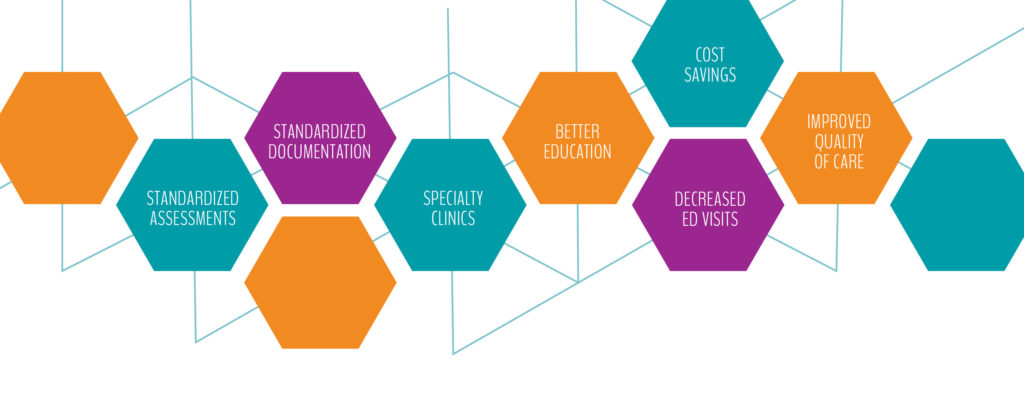QI Project Increases Value of Asthma Care in a Large Primary Care Network
QI Project Increases Value of Asthma Care in a Large Primary Care Network https://pediatricsnationwide.org/wp-content/uploads/2018/10/Q1-Project-1024x393.jpg 1024 393 Kevin Mayhood Kevin Mayhood https://secure.gravatar.com/avatar/bd57a8b155725b653da0c499ae1bf402?s=96&d=mm&r=g- October 22, 2018
- Kevin Mayhood

Multiple steps lead to better control of disease, fewer emergency department visits and $5 million in savings.
A quality improvement project helped kids achieve better control of their asthma, reduced emergency room visits and cut costs in a primary care network serving 10,000 children with the disease.
Through multiple steps, including standardizing assessments and documentation, opening asthma specialty clinics within network offices and providing better education to patients and parents, the long-term project decreased emergency department (ED) visits by 4 percent annually from 2010 to 2016, or a total of 24 percent. Savings totaled more than $5 million while the quality of care improved.
Project leaders at Nationwide Children’s Hospital Primary Care Network (PCN) suggest that the project – in part or completely – can be implemented at other institutions.
More than 6 million children in the United States suffer from asthma, one of the most common long-term noncommunicable diseases, according to the Centers for Disease Control and Prevention. African-American children suffer at nearly twice the rate of white children and the poor at significantly higher rates than those above the poverty line.
The project, which won a Children’s Hospital Association Pediatric Quality Award last year, took aim at the most vulnerable patients. The patient population is diverse, urban and 90 percent of families are Medicaid eligible. The PCN serves patients from 13 offices, located largely in pockets of poverty in central Ohio’s Franklin County.
“As a primary care network, we changed how we think about and treat asthma,” says Dane Snyder, MD, section chief of Ambulatory Pediatrics at Nationwide Children’s and a project leader.
“A lot of things go into that; one is recognizing that what you’re doing is not necessarily a best practice. There was room for improvement and standardization,” says Judith Groner, MD, a primary care physician and another leader of the effort. Other core team members include Steve Hersey, MD, Elizabeth Allen, MD, and Jeanne Wickliffe, RN, CPN.
When the project team began, emergency department visits – an indication of poor asthma control – were increasing. Poor control is known to cause children to miss school days, suffer from poorer academic performance, and cause parents to miss work.
The first steps to address the issues were developing standardized questions to assess children with asthma, and a standardized and more efficient way to document the assessment in electronic medical records.
To improve asthma control, the PCN staff changed from talking with a patient and family about the disease only when family brought it up to bringing it up each time the child came in, no matter the reason. The PCN also set a goal of administering the Asthma Control Test or Childhood Asthma Control Test to at least 70 percent of children with the disease at each visit, no matter the reason. The network met the goal within six months and has exceeded it since.
An alert added to the electronic medical record was a key to assessing and testing children more frequently.
One result of more consistent and frequent monitoring was that physicians increased their employment of medicines for poorly controlled asthma, instead of sending the child to a pulmonologist.
Another change was the addition of an “orange” level to the action plan the PCN provides each patient at each visit. The plan is color-coded red, orange, yellow and green, corresponding with the severity of symptoms from severe to absent.

Parents told PCN staff that they thought bringing their child to the ED when symptoms got bad was a normal part of the disease. Through the addition of “level orange,” the team encouraged families to bring their children to the PCN before symptoms reach emergency levels.
“We can manage almost all kids in the primary care setting,” Dr. Groner says. “Instead of sending a child to a specialist, people are comfortable maximizing what they can do in primary care.”
A year after the project got off the ground, the network started a pilot asthma specialty clinic at one office and gradually spread clinics to all locations. The clinic enabled the staff to spend more time with patients, particularly high-risk and more complex patients they would have sent to a specialist in the past.
Staff created an asthma patient registry to contact patients regularly. They monitored patients by employing the standardized assessment and documentation and obtained spirometry when indicated. A multidisciplinary team provided the patient and family with education, including tutorials on a computer tablet.
Asthma emergency department visits by children in this group declined by more than 25 percent each year from 2013 to 2015, while patients receiving the usual care saw increases in ED visits ranging from 3.8 percent to 16.2 percent during those years.
The project added two asthma health coaches, registered nurses who proactively contacted high-risk patients. As that proved beneficial, the PCN expanded the health coach team to include four registration specialists who handle outreach and four RNs who work in the asthma specialty clinics held in each office.
“With a population this large, it takes resources, not only in personnel but in training,” Dr. Snyder says. “We have several hundred people involved; it took all 100 providers and several hundred nurses and staff to commit.”
The team believes still too many network kids are going to the emergency room. To reduce numbers further, the PCN has begun opening walk-in clinics.
The medical records team continues working on ways to make it easier for the clinicians to do their job. They’ve developed a sidebar in the electronic records that allows providers to quickly see key indicators of risk, such as a child’s last hospital visit and number of times in the hospital. The hospital’s Research Information Solutions and Innovation team is developing a risk scoring system to help predict which children are at greatest risk of an emergency room visit for asthma in the next year. This risk score will be displayed in the sidebar of the electronic medical record for the clinician to easily view.
References:
- Sangvai S, Hersey SJ, Snyder DA, Allen ED, Hafer C, Wicklifffe J, Groner JA. Implementation of the Asthma Control Test in a large primary care network. Pediatric Quality and Safety. 2017 Aug 21;2(5);e038.
- Snyder DA, Thomas OW, Gleeson SP, Stukus DR, Jones LM, Regan C. Shamansky A, Allen ED. Reducing emergency department visits utilizing a primary care asthma specialty clinic in a high-risk patient population. Journal of Asthma, 2018 Jul;55(7):785-794.
Image credits: Nationwide Children’s
About the author
-
Kevin Mayhoodhttps://pediatricsnationwide.org/author/kevin-mayhood/
-
Kevin Mayhoodhttps://pediatricsnationwide.org/author/kevin-mayhood/April 25, 2015
-
Kevin Mayhoodhttps://pediatricsnationwide.org/author/kevin-mayhood/April 25, 2015
-
Kevin Mayhoodhttps://pediatricsnationwide.org/author/kevin-mayhood/April 25, 2015
- Post Tags:
- Asthma
- General Pediatrics
- Posted In:
- Features







